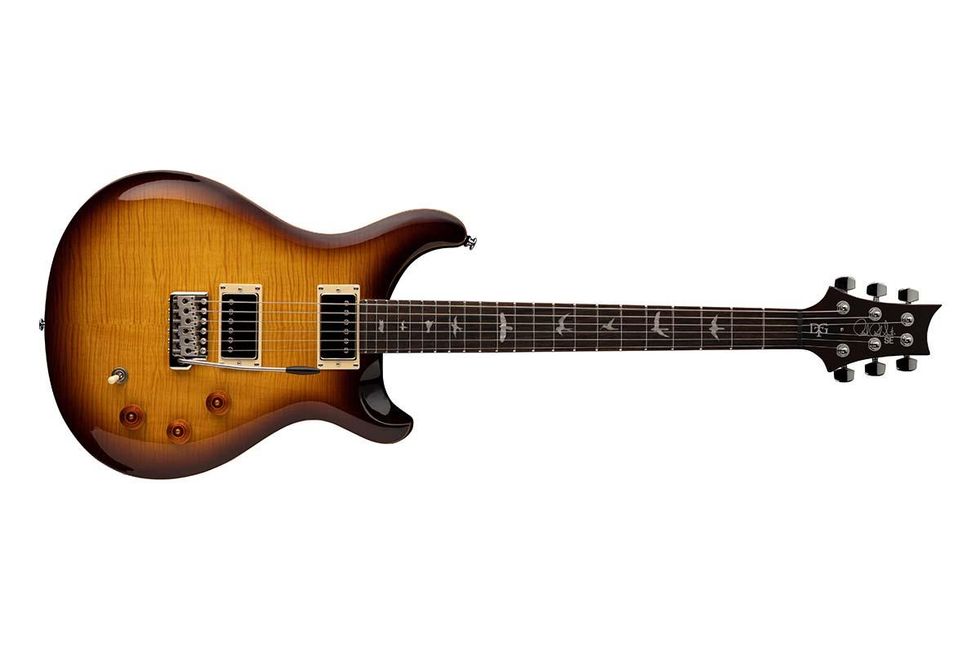It’s amazing how great affordable gear can be these days. But PRS’s imported SE Series combines quality and value in a way very few companies manage. The PRS SE DGT is yet another professional-grade, gig-ready model at a head-turning price. And even among a roster of other SE guitars that offer spectacular quality and playing experience for the money, the SE DGT might just be the company’s best budget-friendly offering yet.
David Grissom, a beast of a guitarist who needs little introduction, has a relationship with PRS dating to the mid-eighties, when he and Paul met at a guitar show. Grissom had already purchased a PRS, but he was a willing sounding board for Paul Reed Smith’s ideas. In 2007 the collaboration led to an official DGT model, which blossomed out of the company’s McCarty model. Today, both the McCarty and DGT are quintessential PRS designs and arguably some of the most recognizable models the company has to offer.
The neck profile, which Grissom says is identical to his own 2010 core version, has a mid-50’s Les Paul feel. It’s full, but not too chunky.
Designing an affordable version of a much-loved, pre-existing high-end model is not easy. And when talking about an $859 version of a $4K instrument, you accept that concessions are made. But knowing how to identify and preserve the essentials of an instrument is a PRS talent, and the SE DGT speaks to their status as masters of the process.
Looks That Thrill
The SE DGT comes in two different finishes: gold top (with moon inlays) and McCarty tobacco sunburst (with bird inlays). The latter finish adorns our review model and it sported a beautiful 2-piece, flame maple veneer that would be at home on a more expensive instrument. The fit and finish on the SE DGT was near immaculate, and the fret work was good as it is on guitars twice the price. Even the pots feel satisfying to the touch.
It was obvious that PRS tried to keep the bones of the SE version as close as possible to the $4k core DGT. Both guitars have mahogany bodies and necks along and the same DGT neck carve. The neck profile, which Grissom says is identical to his own 2010 core version, has a mid-50’s Les Paul feel. It’s full, but not too chunky. The SE version of the PRS patented tremolo is molded metal rather than machined as it is on the core model. Nevertheless, it holds tune even after a wash of aggressive wiggle stick bends. Under the hood, the control cavity is coated with metallic shielding paint and there’s a treble bleed circuit on each volume pot.
Texas-Sized Tones
Grissom’s trademark sounds are generally thick, distorted tones. He’s a blues-rocker through and through. So even many of his clean tones are less pristine than you think. Grissom, in his own estimation, stays on the bridge pickup for about 90 percent of the night when he’s playing his own music. And in several interviews around the release of the SE DGT, Grissom alluded to a very specific recipe for the pickups in his core DGT models, which were the benchmark for the SE variations. Grissom shied away from divulging specifics, but the alnico 2 pickups are very much in the vintage vein. The bridge pickup measures 8.7k ohms and the neck is 7.6k ohms—both comfortably in the low-output range.
The bridge pickup, so essential to Grissom’s sound, is clear and full-throated.
The controls on the SE DGT include volume controls for each pickup and a master push/pull tone knob that triggers the coil-tap function. Each of the pickups utilizes the inner coil in coil-tap mode. Because Grissom relies so heavily on the bridge pickup, the bridge pickup volume control is closest to your hand—the reverse of most guitars with independent volume controls for each pickup. It can take a while to get used to.
The most impressive aspect of the DGT “S” pickup’s performance is the bass response. With the Revv D20 and Bad Cat 15R used here for evaluation, I tend to keep the bass control on both amplifiers at around 5 or 6. But with the SE DGT I kept it closer to 3 to accommodate the pickup’s robust bass. The bridge pickup, so essential to Grissom’s sound, is clear and full-throated. The high end is airy and almost Telecaster-like. And with the right attack I got a tone somewhere between Mark Knopfler and Albert Lee. Pretty cool.
One of the most useful features on the SE DGT is the coil-tap feature. To my ear, the coil-split sounds are more Gretsch-like than Fender-like. And while you hear a slight drop in volume in isolation, it’s nearly unnoticeable at stage volume. The tapped tones are rich and springy. Even better, they keep much of the low end intact and sound beautiful with overdrives.
The Verdict
For just $899 ($849 for the gold top), the PRS SE DGT comes very close to replicating the playing experience of its much more expensive inspiration. The playability is top notch. The pickups sound fantastic. And the SE’s build is a marvel for the money. With the core version of the DGT selling for about $4,000, this PRS SE DGT will be a most welcome option for players with real-world budgets.
















![Rig Rundown: Russian Circles’ Mike Sullivan [2025]](https://www.premierguitar.com/media-library/youtube.jpg?id=62303631&width=1245&height=700&quality=70&coordinates=0%2C0%2C0%2C0)




